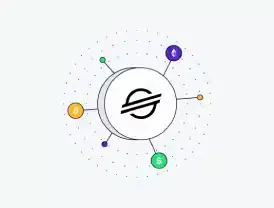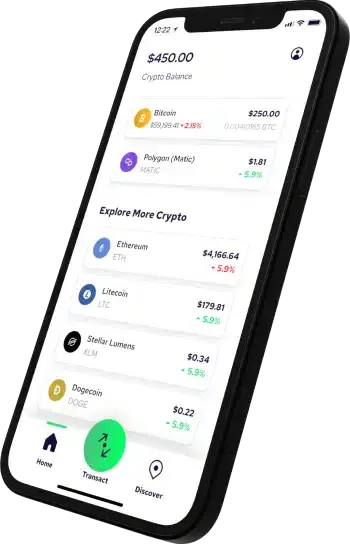What Is Stellar Lumens?
The mainstream global financial system is a highway littered with roadblocks and tolls. Legacy cross-border payment systems, such as wire transfers, have historically suffered from long processing times, high fees, and inconvenient procedures. Sending money from one country to another country might either be impossible due to a lack of technological relationship or might require you to pay multiple fees as your money passes through several systems in just a single money transfer.
The Stellar network is trying to change all that. Founded in 2014 by Jed McCaleb and Joyce Kim, Stellar makes it possible to create, send, and trade digital representations of all forms of money, such as dollars, pesos, or digital assets — you can transact with pretty much any form of currency. It’s specifically designed to make traditional forms of money more useful and accessible, and it does this with its blockchain technology. The Stellar blockchain, which acts as a distributed ledger recording all transactions, is designed to connect all financial systems around the world to work together to create a single, global financial network.
Cross-border payments are a vital lifeline for 1 billion people across the world. Each year, over $500 billion of U.S. dollars in value are transferred across borders, most notably through personal remittances. Frequently, these remittances are sent as transfers from foreign workers to family members in their home countries or, even in some cases, to refugees. Not only do remittances support millions of families, they also make up a significant portion of the GDP in low- and middle-income countries.
But sending these essential remittances is far from a simple ordeal, and is not a borderless or frictionless experience — with a typical transaction costing around $200-to-$300, incurring an average retail cost of around 7%-to-8% of the remittance total (and as high as 15% when transferring money to people in developing economies), and taking days to settle. In short, today’s system leaves millions of people marginalized.
Though the network was designed to be cryptocurrency-adjacent, not favoring any particular currency, the Stellar network does have its own native digital currency, called the lumen, which is required in small amounts for initializing accounts and making transactions. We want to explain everything Stellar and lumens so you can talk about them like a pro.
Though this guide is meant to provide a broad understanding of Stellar and its capabilities, it is not meant to be all-encompassing. We want this guide to be your launching pad into the Stellar ecosystem, providing you with a starting block, enabling you to know what questions to ask to further your education.

What is Stellar?
Stellar and lumens actually refer to two different, distinct items. But, for some reason, the crypto ecosystem has combined the names of Stellar and lumens as a pithy way to refer to the combination of the blockchain and its native digital currency. However, this can often be confusing to many people, as frequently the names get combined in the wrong context on many occasions and are used incorrectly.
And so, for the sake of clarity, let’s clear this up so you can be as knowledgeable as possible: Stellar refers to the blockchain network and lumens refers to the actual digital currency that is represented by the XLM token. Though Stellar lumens is often used to refer to the XLM token, the correct term would be to just use the word lumens.
So what exactly is the Stellar? As we mentioned earlier, Stellar is an open-source payment technology that was built with the intention to enhance, rather than undermine or replace, the existing financial system. It is focused on developing markets and has multiple use cases for its technology, including money remittances and bank loan distribution to the unbanked.
Stellar was built to reduce the friction that exists today in a way that both furthers financial inclusion and sets a new global payment standard, so that where you live — and what you have — can no longer prohibit you from participating in the financial system. With the Stellar network, sending payments anywhere in the world can be as easy as sending an email. With its technological innovation, it aims to connect financial institutions and drastically reduce the cost and time required for cross-border transfers.
This is possible thanks to the speed and scale of the Stellar blockchain. Stellar allows users to exchange between fiat and digital currencies through anchors — that’s the Stellar term for the regulated financial institutions, money service businesses, and financial technology companies that issue 1:1 fiat-backed tokens and provide on/off ramps into local payment systems. These tokens act as a digital representation of the currency you’ve deposited using the Stellar network.
These anchors help create a world where the existing financial system is connected to, and interoperates with Stellar. This enables users to send and receive money quickly and transparently, while avoiding the fees and latency traditionally associated with cross-border and cross-currency remittances. This is all possible without needing prior knowledge of, or familiarity with, blockchain.
Currently, the Stellar network’s development is supported by the Stellar Development Foundation (SDF). The Foundation helps maintain Stellar’s codebase, supports the technical and business communities around Stellar, and is a speaking partner to regulators and institutions.
What are lumens?
Even though Stellar was initially made to support digital representations of any currency, it also developed its own native token, called the lumen. The lumen token was created to fill a special role within the network, as we’ll discuss.
Stellar was built with the goal of being a fast and efficient payments system; however, without some nominal barrier or cost, Stellar’s ledger system could become filled with spam or nonsense, or be used as a kind of arbitrary database system, which would defeat the purpose of the network. Thus, a need for lumens arose out of a need to eliminate any major hiccups initiated by shady users. The token is necessary to initialize accounts and to enable transactions. By design, Stellar requires that each account hold a small number of lumens at all times.
With the injection of even the slightest bit of friction in the form of a minimum account balance and a very small per-transaction fee, the SDF has deterred bad or frivolous actors on the network. As of now, the lumen requirement for users is modest, with just a few tokes being more than enough for most accounts — the minimum account balance is 1 lumen and the minimum per-transaction fee is 0.00001 lumen.
These requirements have been big enough to discourage large-scale bad behavior while being small enough to keep Stellar widely accessible.
The creation of a token that was native to the Stellar network was ideated with a purpose. Stellar, being a universal system for digital money, could’ve allowed people to pay these costs in fiat currency, such as US Dollars or Euro. However, its creators didn’t feel this was appropriate for three main reasons. First, the network wanted to create a digital-first asset that would embrace the openness of the internet.
Secondly, they wanted to use a currency that would be independent of economic and political factors. And third, they didn’t want the network to “prefer” any particular national currency — if Stellar used dollars, for example, then network prices would stay fixed for Americans but float for everyone else. So, the SDF created the network’s own currency — the lumen — intended solely for denominating network requirements.
Unlike the tokens of other blockchains, lumens aren’t mined or awarded by the protocol over time. Instead, 100 billion lumens were created when the Stellar network went live, and for roughly the first 5 years of Stellar’s existence, the supply of lumens increased by 1% annually.
That inflation mechanism was ended by community vote in October 2019, and in November 2019, the overall lumen supply was reduced. There was a cap placed on the supply of lumens at about 50 billion total, of which roughly half are currently in circulation.
How Stellar works — the Stellar consensus protocol
How does Stellar work? How does Stellar manage to run a frictionless, open-source, cross-border payment network? Its success is in large part due to its underlying consensus mechanism, called the Stellar Consensus Protocol (SCP). Stellar’s basic operation is similar to that of most decentralized payment technologies — fast, transparent, and smooth transactions are processed and verified by a protocol that allows network participants to reach consensus via voting, rather than by mining.
Whereas typical mining processes — such as a Proof-of-Stake or Proof-of-Work mechanism — are associated with large financial costs and high energy requirements, transactions verified via voting are processed quickly. The Stellar Consensus Protocol uses the Federated Byzantine Agreement (FBA), which relies upon quorum slices (or a portion of the network) to approve and validate a transaction.
Each node in the Stellar network chooses another set of “trustworthy” nodes. Once a transaction is approved by all nodes within this set, then it is considered approved. The shortened process has made Stellar’s network extremely fast and it is said to process as many as 1,000 network operations per second.
Transactions are verified, on average, within 3-to-5 seconds, with the possibility of thousands of transactions occurring simultaneously. This makes the Stellar network a fast, sustainable, and convenient payment solution for cross-border transactions.
The importance of interoperability
Blockchain technology is challenging us to think about money and value in a new way, presenting opportunities to transact and handle money in more effective and efficient ways. In much the same way that the internet democratized access to information, blockchain technology democratizes access to the financial system.
It’s been decades since the current financial system was modernized, but Stellar is striving to establish a new, large-scale, global payments system. To do that, it was built for interoperability — connecting current financial systems and payment rails with new digital processes so that value and money can flow seamlessly across borders.
No matter where you are in the world, the Stellar network can connect financial infrastructures and institutions, creating an interoperable system across the globe. This is the power of Stellar, building towards a world where equitable access is a right and not just a privilege.



